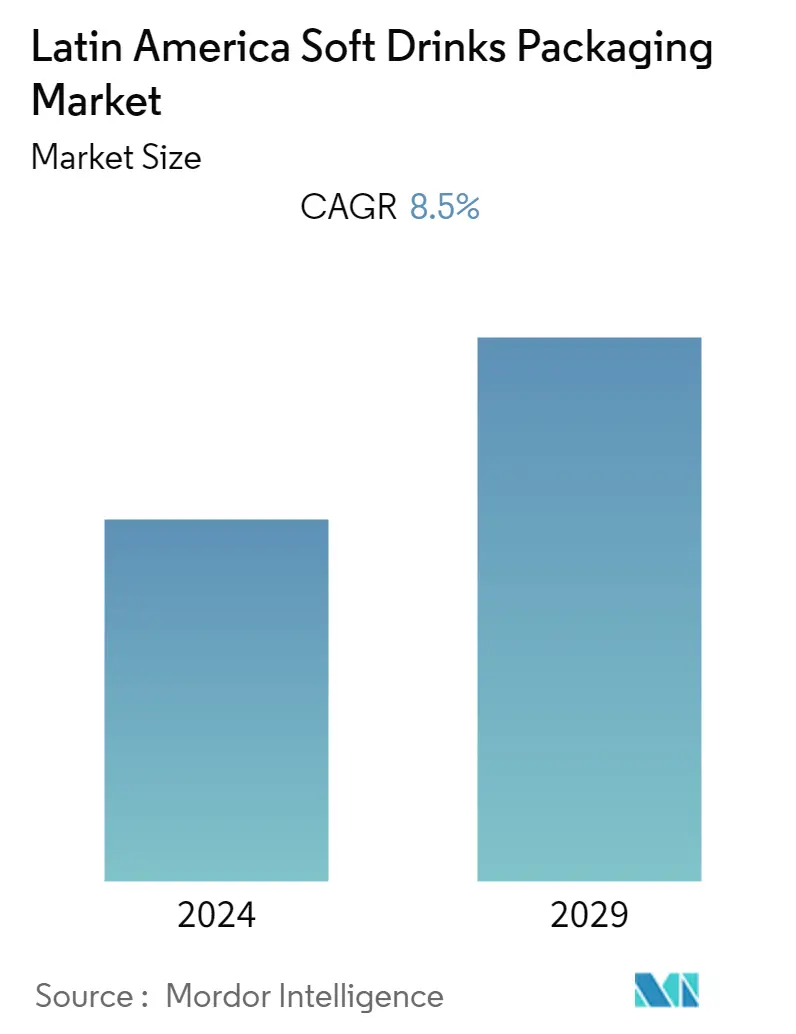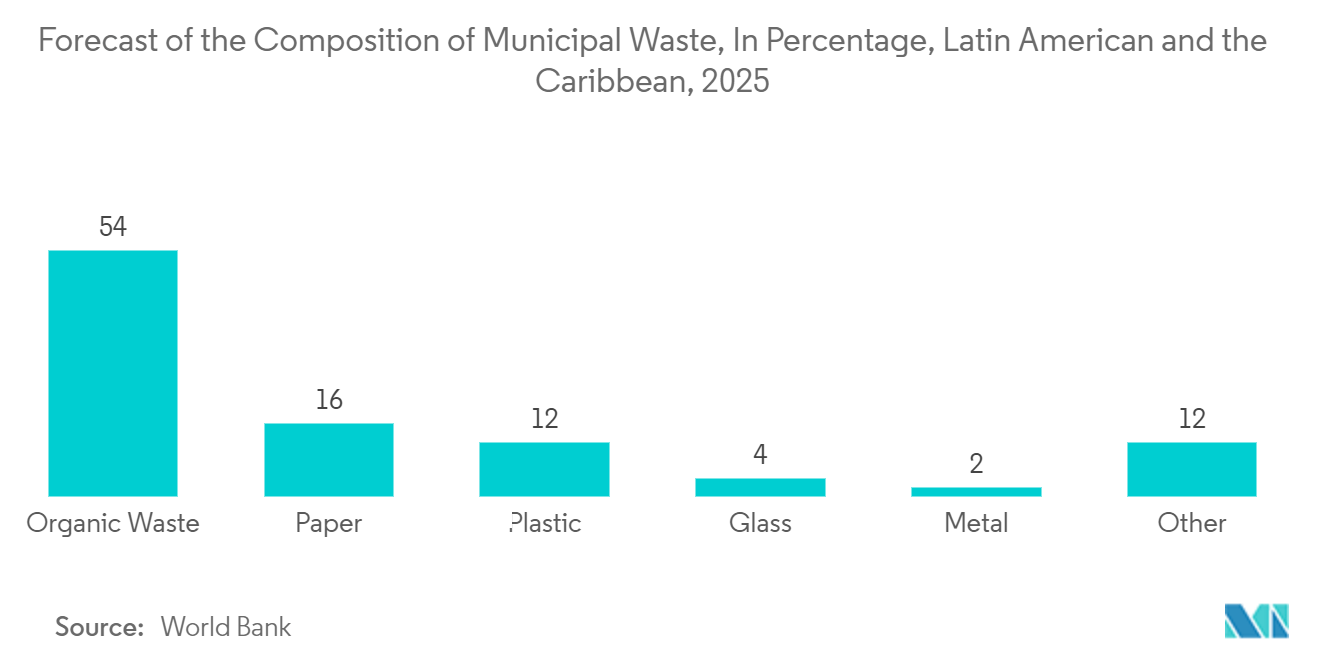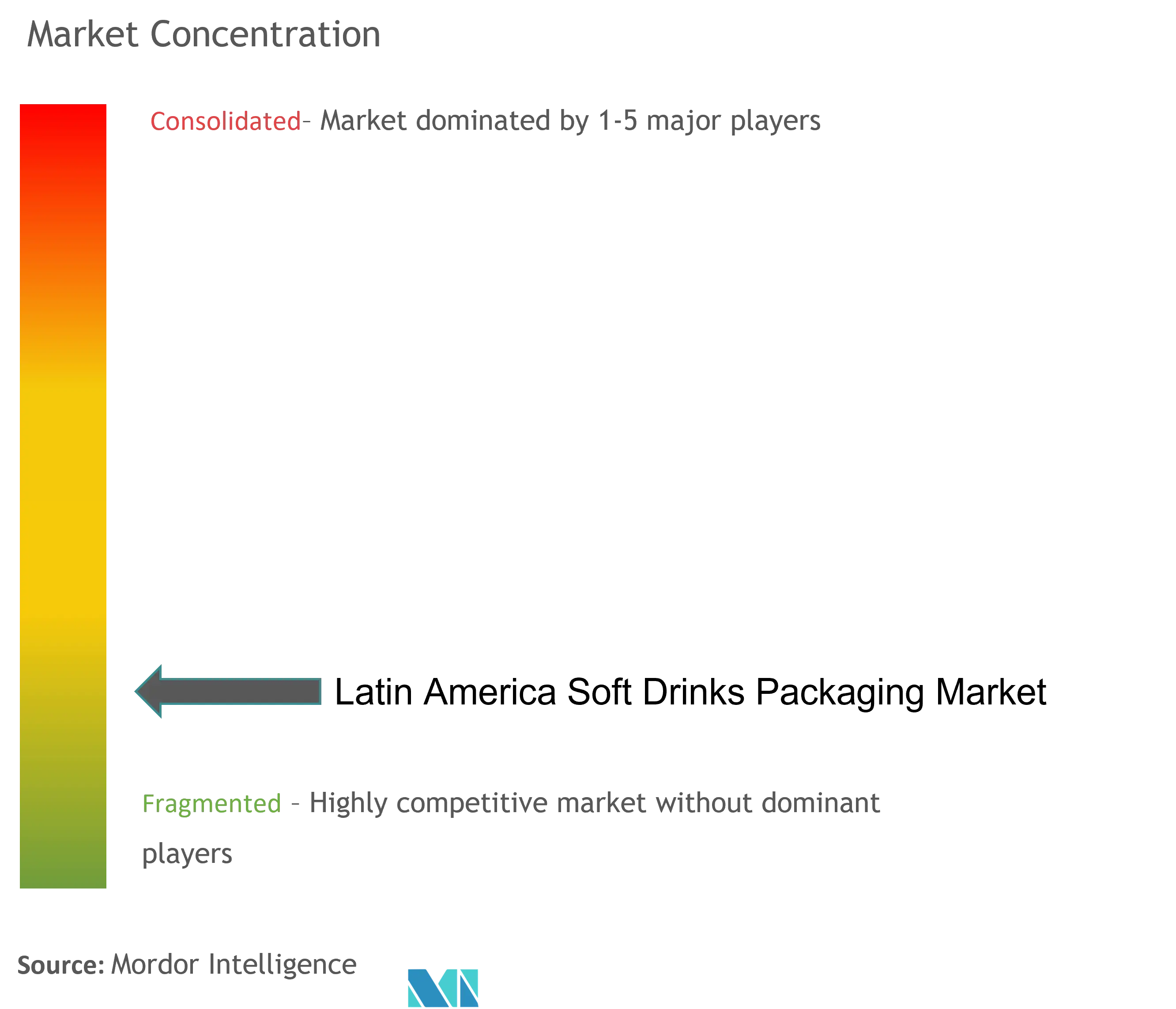Latin America Soft Drinks Packaging Market Size

| Study Period | 2019 - 2029 |
| Base Year For Estimation | 2023 |
| Forecast Data Period | 2024 - 2029 |
| Historical Data Period | 2019 - 2022 |
| CAGR | 8.50 % |
| Market Concentration | Low |
Major Players
*Disclaimer: Major Players sorted in no particular order |
Latin America Soft Drinks Packaging Market Analysis
The Latin America Soft Drinks Packaging Market is expected to register a CAGR of 8.5% over the forecast period. Although carbonated soft drink (CSD) consumption is high in the Latin America region, consumer-led health and wellness trends could take a toll on continued growth.
- The demand for soft drinks in Latin America is attributed to GDP growth and increasing consumer purchasing power. Ready-to-drink teas and bottled water will be key opportunity areas, as soft drink consumption in Latin America has been the bright spot for soft drink brand owners and bottlers.
- Soft drinks are the second most consumed drink after water, with plastic being the most used material for soft drink packaging. The increasing population and rising disposable income have led to an increase in demand for soft drink products across the region. However, government regulations for the use of non-biodegradable packaging solutions are restraining the growth of soft drink packaging.
- Efficient packaging solutions offer benefits like ease of use, disposal, and enhanced user experience. These advantages have resulted in an increase in demand for soft drink packaging solutions.The other trend augmenting demand is the introduction of new and alternative products, which helps manufacturers enhance their brand visibility while offering product differentiation. For instance, in April 2022, Honest Tea expanded its testing bottled beverage portfolio with a new caffeinated ready-to-drink, Honest Yerba Mate.
- According to a survey conducted by the Brazilian Ministry of Health, more than half of the adult population in Brazil is overweight. Brazilian consumers blame alcohol consumption for the problem, so they limit their alcohol consumption as part of personal health management.This gives soft drink companies more chances to sell alcohol alternatives to people who care about their health.
The COVID-19 pandemic impacted the soft drink packaging market negatively. The pandemic situation disrupted the supply chain and reduced customers' disposable income, resulting in less consumption during the COVID-19 pandemic period. Sharp recessionary effects, as well as post-pandemic wellness and health priorities, would have a negative impact on the industry. In addition, the pandemic has shifted the focus of soft drink companies from range rationalization to investment in larger formats and working around direct-to-consumer marketing. Further, the Russia-Ukraine war has an impact on the overall packaging ecosystem.
Latin America Soft Drinks Packaging Market Trends
This section covers the major market trends shaping the Latin America Soft Drinks Packaging Market according to our research experts:
Plastic is Expected to Hold the Significant Share
- Plastic bottles are usually preferred for packaging soft drinks as they are cheaper, easier to transport, and safer. Also, plastics are energy efficient to manufacture, and they are also lighter than alternative materials.
- The adoption of PET plastic bottles helps in weight reduction as compared to glass, allowing for a more economical transportation process. Additionally, better mechanical qualities reduce weight compared to PE and PP bottles. Further, the availability of recycled plastic in the region is considered among the cheapest. This has also helped increase the rate of recycling PET in the region.
- With the expansion of the soft drinks market in Latin America, it is clear that nutritional product demand, such as juices, energy drinks, and sports drinks, is increasing and driving the soft drinks packaging market. For example, in September 2021, Pepsi Cola said it would invest USD 64 million to increase production in the Colonia del Sacramento free trade zone in Uruguay.
However, because of the growing environmental concern about the use of plastic for soft drink packaging, which is hazardous, manufacturers and consumers in Latin America are turning to environmentally friendly alternatives to plastic. For instance, in May 2022, SIG launched combistyle carton packaging with Frimesa, one of Brazil's largest milk companies.

Brazil to Contribute Significant Market Share
- Brazil's polyethylene terephthalate (PET) stretch blow molding industry is significantly growing, propelled by carbonated soft drinks, health drinks, and most recently, aseptically filled products like milk beverages, fueled by rising incomes for large segments of the world's fifth-most populous nation that are making things like bottled water and soda newly accessible to everyday Brazilians.
- The companies are investing in Brazil to maintain a better position to serve their customers' growing needs for beverage cans for soft drinks. For instance, in July 2022, Canpack S.A. announced that it would increase its manufacturing capacity of aluminum beverage cans with a new production plant in Pocos de Caldas, Brazil, with an investment of approximately BRL 710 million (USD 140 million), which will be operational in 2024. The capacity of the plant will initially be around 1.3 billion cans per year.
- Furthermore, in February 2022, metal packaging leader Trivium Packaging announced an investment in two of its new manufacturing plants to expand the production of aluminum impact-extruded cans and bottles. In 2023, new lines will be added to the facilities in Youngstown, Ohio, and Itupeva, Brazil. This will give the facilities new capabilities and a lot more space.
- Coca-Cola's report for the second quarter of 2022 says that sales of soft drinks have gone up by 8%. This is due to growth in all geographic operating segments, but Mexico and Brazil have led the way. In addition, nutrition, juice, dairy, and plant-based beverages grew by 6%, led by Del Valle in Latin America.

Latin America Soft Drinks Packaging Industry Overview
The Latin America Soft Drinks Packaging market is fragmented, owing to the presence of many domestic and international players. The market is fragmented with the players competing in terms of price, product design, product innovation, etc. Some of the major players in the market are Amcor Ltd, Sealed Air Corporation, Tetra Pak International, Graham Packaging Company, and Crown Holdings Incorporated among others.
In October 2022, Sidel, a packaging solution provider, launched 1SKIN, a label-less recycled PET bottle to help Sidel's customers achieve their sustainability goals and drive sales of high-end products. The one-liter bottle is destined for the booming market in sensitive juices, teas, and flavored drinks.
In February 2022, Heineken announced that it would invest BRL 320 million (USD 63.8 million) in the Brazilian state of Sao Paulo. Recycling glass packaging is also among the priorities of the company, which would present new initiatives for contributing to the goal of reaching 100% recycling of its packaging used in restaurants and bars by 2025.
Latin America Soft Drinks Packaging Market Leaders
-
Amcor Ltd
-
Tetra Pak International
-
Graham Packaging Company
-
Ball Corporation
-
Crown Holdings Incorporated
*Disclaimer: Major Players sorted in no particular order

Latin America Soft Drinks Packaging Market News
- August 2022 : Avantium N.V., one of the leading technology companies in renewable chemistry, signed an offtake agreement with the Brazilian brewing company AmBev. Through this agreement, AmBev will purchase PEF (polyethylene furanoate), a 100% plant-based and recyclable alternative to plastic from Avantium's Flagship Plant, and will use it to make bottles for its soft drinks portfolio.
- February 2022 : The Coca-Cola company announced a goal to boost the use of reusable packaging. By 2030, the company hopes to have sold at least 25% of all beverages globally in refillable/returnable glass or plastic bottles, or in refillable containers via traditional fountain or Coca-Cola Freestyle dispensers.
Latin America Soft Drinks Packaging Market Report - Table of Contents
1. INTRODUCTION
- 1.1 Study Assumptions and Market Definition
- 1.2 Scope of the Study
2. RESEARCH METHODOLOGY
3. EXECUTIVE SUMMARY
4. MARKET INSIGHTS
- 4.1 Market Overview
- 4.2 Industry Value Chain Analysis
-
4.3 Industry Attractiveness - Porter's Five Forces Analysis
- 4.3.1 Bargaining Power of Suppliers
- 4.3.2 Bargaining Power of Buyers
- 4.3.3 Threat of New Entrants
- 4.3.4 Threat of Substitute Products
- 4.3.5 Intensity of Competitive Rivalry
- 4.4 Assessment of the Impact of COVID-19 on the Market
- 4.5 Overview of the Global Soft Drinks Packaging Market
5. MARKET DYNAMICS
-
5.1 Market Drivers
- 5.1.1 Increasing Disposable Income and Growing Economies
- 5.1.2 Growing Demand for Ready-to-use Drinks
-
5.2 Market Restraints
- 5.2.1 Stringent Government Regulations Against Non-biodegradable Products
6. MARKET SEGMENTATION
-
6.1 By Material
- 6.1.1 Plastic
- 6.1.2 Metal
- 6.1.3 Glass
- 6.1.4 Paper and Paperboard
-
6.2 By Product Type
- 6.2.1 Bottles
- 6.2.2 Cans
- 6.2.3 Boxes
- 6.2.4 Cartons
-
6.3 By Type
- 6.3.1 Bottled Water
- 6.3.2 Carbonated Drinks
- 6.3.3 Juices
- 6.3.4 RTD Beverages
- 6.3.5 Sport Drinks
-
6.4 By Country
- 6.4.1 Brazil
- 6.4.2 Mexico
- 6.4.3 Argentina
- 6.4.4 Rest of Latin America
7. COMPETITIVE LANDSCAPE
-
7.1 Company Profiles
- 7.1.1 Amcor PLC
- 7.1.2 Graham Packaging Company
- 7.1.3 Ball Corporation
- 7.1.4 Crown Holdings Incorporated
- 7.1.5 Tetra Pak International
- 7.1.6 CAN-PACK SA
- 7.1.7 Refresco Group NV
- 7.1.8 Ardagh Group SA
- 7.1.9 Victory Packaging
- 7.1.10 Trivium Packaging
- *List Not Exhaustive
8. INVESTMENT ANALYSIS
9. FUTURE OF THE MARKET
** Subject To AvailablityLatin America Soft Drinks Packaging Industry Segmentation
The Latin America Soft Drinks Packaging Market is tracked by the consumption of soft drinks and revenue accrued from the sales of soft drinks packaging products provided by different vendors having a presence in the region. The study also encompasses the assessment of the impact of COVID-19 on the market with the current market estimates and future projections during the forecast period, considering the impact of the same on the market. The Latin America Soft Drinks Packaging Market is segmented by Material (Plastic, Metal, Glass, Paper, and Paperboard), Product Type ( Bottles, Cans, Boxes, Cartons), Type (Bottled Water, Carbonated Drinks, Juices, RTD Beverages, Sports Drinks) and Country (Brazil, Mexico, Argentina, Rest of Latin America).
The market sizes and forecasts are provided in terms of value (in USD million) for all the above segments.
| By Material | Plastic |
| Metal | |
| Glass | |
| Paper and Paperboard | |
| By Product Type | Bottles |
| Cans | |
| Boxes | |
| Cartons | |
| By Type | Bottled Water |
| Carbonated Drinks | |
| Juices | |
| RTD Beverages | |
| Sport Drinks | |
| By Country | Brazil |
| Mexico | |
| Argentina | |
| Rest of Latin America |
Latin America Soft Drinks Packaging Market Research FAQs
What is the current Latin America Soft Drinks Packaging Market size?
The Latin America Soft Drinks Packaging Market is projected to register a CAGR of 8.5% during the forecast period (2024-2029)
Who are the key players in Latin America Soft Drinks Packaging Market?
Amcor Ltd, Tetra Pak International, Graham Packaging Company, Ball Corporation and Crown Holdings Incorporated are the major companies operating in the Latin America Soft Drinks Packaging Market.
What years does this Latin America Soft Drinks Packaging Market cover?
The report covers the Latin America Soft Drinks Packaging Market historical market size for years: 2019, 2020, 2021, 2022 and 2023. The report also forecasts the Latin America Soft Drinks Packaging Market size for years: 2024, 2025, 2026, 2027, 2028 and 2029.
Latin America Soft Drinks Packaging Industry Report
Statistics for the 2024 Latin America Soft Drinks Packaging market share, size and revenue growth rate, created by Mordor Intelligence™ Industry Reports. Latin America Soft Drinks Packaging analysis includes a market forecast outlook to (2024to2029 and historical overview. Get a sample of this industry analysis as a free report PDF download.



